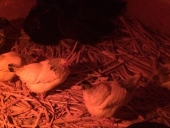There's a modest stock pond (about 1/4 acre) on our land. It was constructed 20-30 years ago by the then-lessee of the grazing rights, for the benefit of his cattle. It's well-made with a sound dam, and in the nine or ten years I've been looking at it (including a multi-year drought) it has never gone dry, nor has it ever filled deep enough to drain out the spillway. It is fed by surface runoff from road culverts and ditches along the property boundary and also drains runoff from an area of adjacent pasture on the other side of the road that's still in grazing use; if there ever was a running stream in this drainage it has been impounded by the rancher's up-gradient stock ponds.
The pond is in decent ecological shape, supporting numerous turtles and frogs. There's some underwater aquatic vegetation and algae, but it is minimal. There are some cattails in the drainage area above the pond, but not many. Perhaps 30% of the pond perimeter is dam with grass and weeds, and a similar amount is forest; the rest is grass or the edge of a clean weedy gravel pad that supports oil extraction operations. There is one small willow tree growing near the putative spillway area that never actually overflows; the rest of the trees are at the top of the pond and are mostly various kinds of oaks and a few Osage Orange, juniper (red cedar), and ash trees.
What there is NOT is any evidence of fish in the pond. It was created on a slope that drains into ravines that have seasonal streams in them, but it wasn't created in an existing natural stream and there's no continuous flowing-water pathway for fish either above or below the pond. Observing the pond there are never any visible minnows, nor any jumping or feeding fish. Clarity of the water is good enough that fish in the shallows would be visible when the light is good. Nor have I ever seen waterfowl of any kind feeding or living in the pond. At some point a beaver visited and cut a few trees, but those stumps are many years old.
We are not big fish eaters and have no interest in stocking this pond with a fish population that would support fishing by people, nor is
aquaculture on our list of desired hobbies. Also, the pond is marginal in size and depth for getting support from the state's sport-fishing-oriented agricultural pond-stocking program even if we wanted that, which we do not.
My question is this: What, if any, stocking with fish or other aquatic animals should we consider if the goal is to attract and support more wildlife use of the pond? I'm fairly clear on the sorts of on-land improvements one makes to provide habitat for wildlife that might wish to use the pond. It's the food ecosystem I'm unclear about and to a lesser extent the aquatic vegetation. We've got frogs and turtles, but apparently not enough to attract herons and cranes and that sort of bird. Deer drink from this pond, and small rodents live along the shore, but I've never seen any other mammals there. Nor have I ever seen any waterfowl on the pond, though this may have nothing to do with food availability and everything to do with the limited sight lines from water level that may make nervous squawkers uncomfortable.
I've tried to Google this but all the keywords I've tried have turned up mostly resources for people trying to manage their ponds for maximum fish (sport fishing or aquaculture) which means limiting aquatic vegetation and discouraging birds. I'm more interested in managing the pond to promote maximum food resources for birds and mammals; since I don't need this pond for watering cows, I'd like to use it as if it were a natural pond, for wildlife habitat and diversity. It's clear to me that I want more aquatic vegetation, not less, to provide additional habitat for insects and amphibians and reptiles. I'm limited there because the pond was carefully designed for water storage with the steep shores that minimize vegetation. But what about fishy/finny stuff? I've seen some sources that say birds want fish to eat, while others say that birds are perfectly happy with lots of amphibians, which would decline under fish predation. Since this is a pond that apparently isn't going to develop fish populations by natural means, I'm left in a quandary. Do I just manage for making the existing critters happier, or do I introduce local species of fish and other swimmy/leapy/crawlies from other nearby sources?
I realize this is a very open-ended post. I'm obviously not looking for definitive answers, just ideas and feedback. What would you do (if anything) to manage a pond like this for wildlife diversity?

 2
2





 2
2





 2
2












 2
2
























